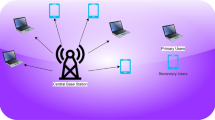Abstract
Next-generation wireless networks should be able to coordinate and integrate different communication systems. It has been a challenging problem to support a seamless handover in these diverse wireless network environments. Link level triggers can provide information about events which can help handover decision and layer 3 entities better streamline their handover related activities. In most conventional layer 2 triggering approaches, a pre-defined threshold for a specific perspective such as the received signal strength is used. This may cause too late or too early handover executions. In this paper we propose a new predictive handover framework that uses the neighbor network information to generate timely the link triggers so that the required handover procedures can appropriately finish before the current link goes down. First we estimate a required handover time for the given neighbor network conditions, then using a predictive link triggering mechanism the handover start time is dynamically determined to minimize handover costs. The handover costs are analyzed in terms of the total required handover time and the service disruption time. The numerical analysis and simulation results show that the proposed method significantly enhances the handover performance in heterogeneous wireless networks.
Similar content being viewed by others
References
Institute of Electrical and Electronics Engineers. (2007). Draft standard for Information Technology—Telecommunications and information exchange between systems—Local and metropolitan area networks-specific requirements—Part 11: Wireless LAN Medium Access Control (MAC) and Physical Layer (PHY) Specifications. IEEE Std 802.11.
Institute of Electrical and Electronics Engineers. (2004). IEEE standard for local and metropolitan area networks—Part 16: Air interface for fixed broadband wireless access systems. IEEE Std 802.16.
Institute of Electrical and Electronics Engineers. (2006). IEEE Standard for Local and Metropolitan Area Networks—Part 16: Air interface for fixed broadband wireless access systems, Amendment 2: Physical and medium access control layers for combined fixed and mobile operation in licensed bands. IEEE Std 802.16e, February, 2006.
Institute of Electrical and Electronics Engineers. (2007). Draft standard for local and metropolitan area networks: Media independent handover services. IEEE P802.21/D05.00, April 2007.
Dimopoulou L., Leoleis G., Venieris L.S. (2005) Fast handover support in a WLAN environment: Challenges and perspectives. IEEE Network 19(2): 14–20
Huang, P.-J., Tseng, Y.-C., & Tsai, K.-C. (2006). A fast handoff mechanism for IEEE 802.11 and IAPP networks. IEEE VTC’06, pp. 966–970.
Mhatre, V., & Papagiannaki, K. (2006). Using smart triggers for improved user performance in 802.11 Wireless Networks. ACM Mobisys’06, pp. 246–259.
Woon, S., Golmie, N., & Sekercioglu, Y. A. (2006). Effective link triggers to improve handover performance. IEEE PIMRC06, pp. 1–5.
Bandholz, M., Riihijarvi, J., & Mahonen, P. (2006). Unified layer-2 triggers and application-aware notifications. ACM IWCMC’06, pp. 1447–1452.
Wu, H., Tan, K., Zhang, Y., & Zhang, Q. (2007). Proactive scan: Fast handoff with smart triggers for 802.11 Wireless LAN. to appear IEEE Infocom’07, pp. 749–757.
Lee, D., Han, Y., & Hwang, J. (2006). QoS-based vertical handoff decision algorithm in heterogeneous system. IEEE PIMRC’06, pp. 1–5.
Koodli, R. (2005). Fast handover for mobile IPv6. IETF RFC 4068, July 2005.
Institute of Electrical and Electronics Engineers (2007). Draft standard for information technology—Telecommunications and information exchange between systems—Local and metropolitan area networks-specific requirements—Part 11: Wireless LAN Medium Access Control (MAC) and Physical Layer (PHY) Specifications, Amendment: Radio resource measurement. IEEE P802.11k/D7.0, January 2007.
Yoo S.-J. (2002) Efficient traffic prediction scheme for real-time VBR MPEG video transmission over high-speed networks. IEEE Transactions on Broadcasting 48(1): 10–18
Chevrollier, N., Montavont, N., & Golmie, N. (2005). Handovers and interference mitigation in healthcare environments. IEEE MILCOM’05, October 2005.
Cypher, D., Chevrollier, N., Montavont, N., & Golmie, N. (2006). Prevailing over wires in healthcare environments: Benefits and challenges. IEEE Communications Magazine, pp. 56–63, April 2006.
Rouil, R., & Golmie, N. (2006). Adaptive channel scanning for IEEE 802.16e. IEEE MILCOM’06, pp. 1–6.
Rouil, R., & Golmie, N. (2006). Effect of IEEE 802.16 Link parameters and handover performance for select scenarios. IEEE 802.21 Contribution DCN 21-06-0524-00-0000, February 10, 2006.
Rappaport, T. S. (2002). Wireless communications: Principles and practice. Personal Education International, 2002.
Author information
Authors and Affiliations
Corresponding author
Rights and permissions
About this article
Cite this article
Yoo, SJ., Cypher, D. & Golmie, N. Timely Effective Handover Mechanism in Heterogeneous Wireless Networks. Wireless Pers Commun 52, 449–475 (2010). https://doi.org/10.1007/s11277-008-9633-8
Published:
Issue Date:
DOI: https://doi.org/10.1007/s11277-008-9633-8




